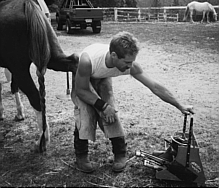
in memory of a friend, Jim Caseber (1959-1996)
photos & story by Carol Prentice, drawings by David Gorman
published in ANVIL Magazine, February 1997
The physically demanding work of the farrier presents unique challenges. It requires awkward stances, and along with the weight of the horse can put a tremendous strain on the spine.
If you've been a farrier for a long time, you've probably developed certain ways in which you mechanically work around the horse and stand at the anvil. If these ways aren't working for you, here are good options to reduce or eliminate strain.
Changing these habitual activities might not be easy at first, but it could just save your spine - not to mention the rest of your body.
The Alexander Technique is a method that works to change habits in our everyday activities. It is a simple and practical method for improving ease and freedom of movement, balance, support and coordination. The technique teaches the use of the appropriate amount of effort for a particular activity, giving you more energy for all your activities. It is not a series of treatments or exercises, but rather a re-education of the mind and body. The Alexander Technique is a method which helps a person discover a new balance in the body by releasing unnecessary tension. It can be applied to sitting, lying down, standing, walking, lifting and other daily activities as well as the unusual activity of shoeing a horse.
Here's how it works: First, you need to have an awareness of what it is you are doing with yourself that is causing tension or strain in the body. Do you lock your knees when you stand at the anvil? Is your stance wide? Do you stand on one leg predominantly? Are you rounding your spine over the anvil or do you use your joints and bend in the hips, knees and ankles, keeping your spine in balance? Do you have tension behind the neck? Do you lock yourself into a position when working around the horse's hoof? Ask yourself these questions. Find out. Begin to notice your own habits.
After you have some awareness of your whole body in movement, look at what F.M. Alexander called the "Primary Control" - the relationship between your head, neck and torso. The average head weighs between 15-20 pounds. Most of us tend to carry it back and down on our spines, compressing the entire spine and tensing the muscles throughout the body. Check out your own head-neck-torso relationship in a mirror. See for yourself what happens when you allow the neck muscles to ease and the head to move slightly more forward up off the spine. It is a very subtle movement, but the effect can bring a feeling of ease (Figure 2).
Once you begin to have that awareness, the next step is to work with what the Alexander Technique calls "giving yourself directions" or mental thoughts that release the muscles into length and width (see illustrated directives).
These are basic; however, you can give directions to virtually all parts of the body. It isn't just about correct body positions but also about releasing the muscles on a neuromuscular level that allows the muscles to lengthen and widen, and allows the skeletal frame to come into balance.
When I first started working with farrier Jim Caseber, he talked about the need to feel locked down and tense in order to do his work: "When I come to a horse, I feel mentally relaxed, but physically I have always felt the need to be somewhat rigid or braced throughout my body in order to support the leg of the horse. (Figures 1, 3A, 3B, 3C)"

Figure 1, to the left. Here Jim is in a classic locked position where he is supporting the horse's near hind with his entire body. Notice the toes pointed in, the roundness of his upper back and the head pulled back. To direct himself into a more balanced stance, he could become more flexible in his hips and in the back of his neck to release tension and to allow for a lengthening of his spine. Thus, he could ease throughout the body, yet maintain control.
After my working with Jim for awhile, he was able to sense kinesthetically for himself that he didn't need to lock himself into a position. He could give himself the mental directions and allow his whole body to stay more flexible. As he put it, "Working with the Alexander Technique, I don't have to over-exert my muscles, but I can let my bones and joints support me. I feel more in balance, less in combat position. (Figures 3D, 3E, 3F)"
Standing at the anvil, Jim tended to lock his knees, stand to one side and round his spine over the anvil (Figure 4A). To improve his balance, he would widen his stance and bending slightly at the hips, knees and ankles. And thinking to maintain a balance through the whole length of the spine, he found he had less hip and lower back pain. He also found that whereas his wrist had hurt from tensing throughout his neck, shoulders and forearms, by changing his primary control, improving his stance and giving in the joints, the pain in his wrist went away (Figure 4B).
Change happens gradually, and the key to change is mental and physical awareness. Changing how you've habitually shod a horse for five or ten years (or even six months) might take a lot of conscious thought. You can begin by just noticing how you are standing or sitting while reading this article.
Start simple and take notice.
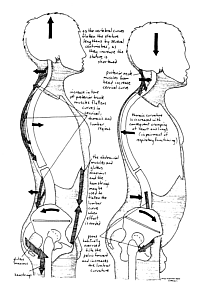
Figure 2. On the right half of the illustration: Before the Alexander Technique is applied. Note the arrows. They indicate the directions the head and spine take when we allow gravity to pull us down.
On the left half of the illustration: Once the Alexander Technique directives are practiced, the head is balanced more freely on top of the spine, allowing the spine to lengthen upward and relieving pressure throughout the spine. Note the arrows.
| Before the Alexander Technique is applied. Jim is shown here in what used to be his typical narrow stance with shoulders hunched, rounding his spine, pulling his head back and down in a locked, braced position. Overexertion of the muscles is required to maintain these stances (Figures 3A, 3B, 3C). | ||
 Tending the fore. |
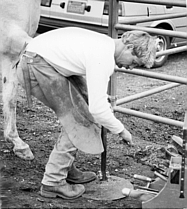 The hoof stand. |
 Tending the hind. |
| Practicing the Alexander Technique. A balanced relationship of his head, neck and torso, combined with active use of his hip, knee and ankle joints, provides the opportunity to exert only the appropriate amount of energy for the job. In applying the Alexander Technique, a person will generally take a shoulder-width stance. Taking into account the weight and movement of the horse, a wider-than-shoulder-width stance is in order (Figures 3D, 3E, 3F). | ||
 Tending the fore. |
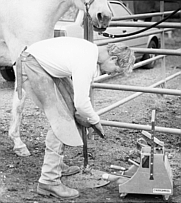 The hoof stand. |
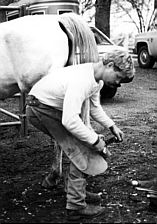 Tending the hind. |
 Figure 4A. Before the Alexander Technique is applied. Here Jim is standing over the anvil. His weight is predominantly on his right hip, his left hip dropped; his knees are locked. His spine is rounded, and his head is pulled slightly back and down. |
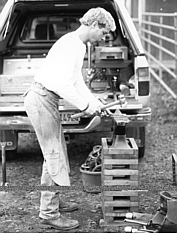 Figure 4B. Practicing the technique. Here Jim is maintaining the Primary Control of his head, neck and torso. He is using a wider, more balanced stance and is bending at the hips, knees and ankles. |
 Directive 1. (left) Before the Alexander Technique is applied. (right) Practicing the Alexander Technique. Allow the neck muscles to ease (free). Allow the head to go forward and up from the spine. |
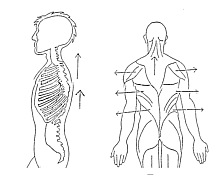 Directive 2. Allow the back to lengthen and widen. |
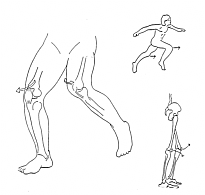 Directive 3. Allow the knees to go forward and away. |
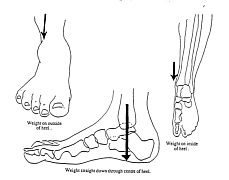 Directive 4. Allow the heels to be down. The center example illustrates the Alexander Technique applied. The other illustrations show typical faults in stance. |
Carol P. Prentice has been a certified Alexander Technique teacher for 11 years. She teaches in Grass Valley and Sacramento, California. Carol is currently offering The Poised Rider Equestrian Clinic applying the Alexander principles to horsemanship throughout throughout the Western states. For more information or to find an Alexander Technique teacher in your area, call Carol at 800-676-1458 or 916-273-3426.
Return to the Farriery Articles listing page.
Return to the ANVIL Online Table of Contents for February, 1997.